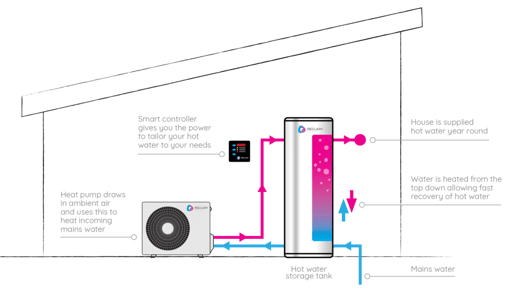In our Learning Centre, we talk a lot about the benefits of hot water heat pumps. We talk about how they can save you money through increased efficiency, the differences between models, and even what might go wrong.
But we haven’t covered a big question: how does a heat pump actually work? In this article, we explain what’s going on inside a heat pump, and how it saves you money.
A heat pump is a fridge in reverse
Obviously, that’s an over-simplification, but it’s an easy way to understand what’s going on. While a fridge removes hot air from inside, a heat pump absorbs ambient heat from the air.
That heat is absorbed by a refrigerant. Premium systems will use CO2, due to its low Global Warming Potential, but there’s a wide variety of refrigerants in use. The warm gas then passes through a compressor, which increases its pressure and temperature.
A heat exchanger transfers the heat from the gas to cold water, which is then pumped to your hot water storage tank. At this point, the refrigerant has cooled down, and can be cycled back into the system – where it can once again absorb heat.
The water comes from your water supply, where it is pumped into the storage tank. Cold water enters the system from the bottom of the tank, and hot water enters, from the heat pump, to the top of the tank. This means faster refill of hot water, since your supply comes from the top.
How does this save money?
A traditional electric water heater works through resistive heating. Essentially, when electric current passes through material, it creates heat. An electric storage system has an electric element designed to generate plenty of heat when a current passes through.
This method is close to 100% efficient. Sending 1kW of electricity through the system will generate 1kW of heating power. Energy efficiency is largely dependent on the insulation of the tank.
Some heat pumps, by contrast, can be around 500% efficient. That means they turn 1kW of electricity into 5kW of heating power. That’s possible because moving heat around the system requires significantly less power than directly heating water does.
If you have an electric storage system and swap to a heat pump with 500% efficiency, you’d be generating 5x the heating power for the same electricity cost. That’s an 80% reduction in electricity bills.

Notably, you won’t always get the same efficiency. Since heat pumps extract heat from the air, hotter days mean they run more effectively, and vice versa when it’s cold. Average CoP can give you an idea of what you’d expect to save overall, but keep in mind that you’re still better off on cold days than you are with an electric storage heater.
Does it always work?
Some days get so cold that a heat pump can’t work at all – there’s just not enough heat in the air to heat your water. The minimum temperature depends on the model of heat pump. The best are able to function up to -10°C, which means almost every Victorian home will be able to have reliable hot water, all year round.
Lower quality heat pumps won’t get you all the way to -10°. These tend to range from -7° to 5°, so it’s important to make sure you’re buying one that’s suited for your climate. You don’t want to wake up and find the night was too cold for you to have hot water.
To compensate for this, some heat pumps will include an electric booster. That works much the same as an electric heater, using resistive heating. The good news is you’ll be able to get hot water overnight; the bad news is, since this doesn’t use the heat pump, it’ll cost a lot more than you’re used to. This means it’s important to pay attention to two things: your heat pump’s minimum operating temperature (remember, -10°C is best), and if it uses an electric booster or not.
Can anything go wrong?
Heat pumps are seriously impressive pieces of technology – but they’re not magic. Like any bit of machinery, there can be problems and faults to deal with.
The biggest problem anyone can have with a hot water system is, obviously, a lack of hot water. This can happen for all sorts of reasons, but two of the most common are unusually high demand and unusually low temperatures.
If your heat pump can’t function below 5°C and you go through a night that’s consistently colder than that, you’re not going to have hot water in the morning. The only way around that is to ensure you get a system with a lower minimum temperature, or to get one with an electric booster and accept the extra running costs.
In cases of high demand – such as if you have guests over and they need showers – you might find your pump works too slowly to deliver reliable hot water. This is a problem that’s best avoided rather than fixed, because there’s not much you can do once you run into it.
Make sure your tank is properly sized for your needs, and that the pump can work fast enough to keep you well supplied with hot water.
To avoid maintenance issues, make sure you have your pump regularly serviced by a professional. Your installer should be able to tell you how often you should be booking servicing.
Want to know more?
If knowing how a heat pump works has you interested in upgrading your current hot water system, don’t stop here. We’ve got articles that explain the right price range, some common questions, and so much more.
Once you’ve learned all you need to know, book an appointment with our team of experts to discuss your options.

